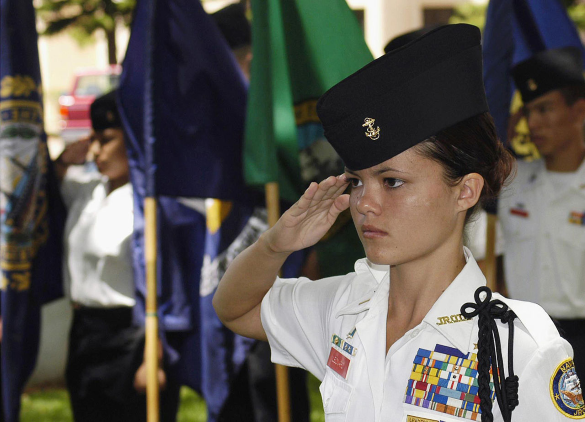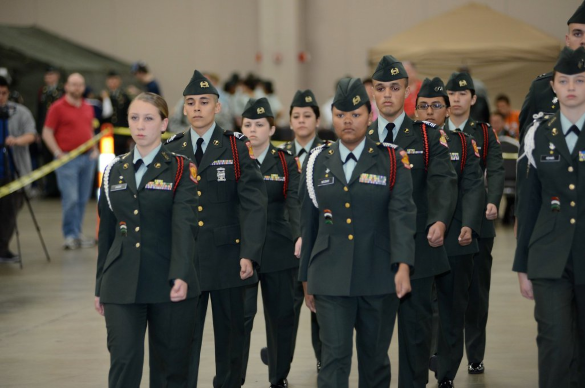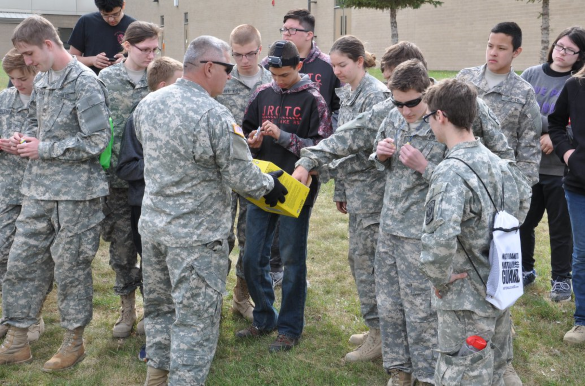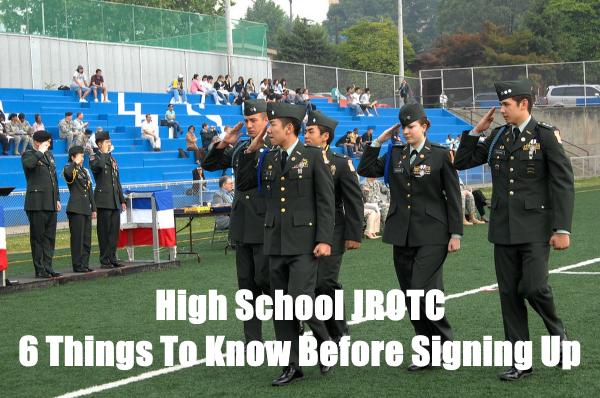Many high schools across the United States offer voluntary JROTC programs for interested students.
This elective course for high schoolers is available at each grade level, and there is no overt or implied commitment to join the military after graduation for students who participate.
The overall focus of JROTC programs is inspiring better citizenship through leadership, character, and educational development.
Here are 6 things to know before signing up for JROTC in high school.
Related Article – Benefits of Joining the Military After High School
Table of Contents
1. What Is JROTC?

JROTC stands for Junior Reserve Officer Training Corps.
This federal program, sponsored by the U.S. Armed Forces, is offered as a course elective for each grade level in high school.
Junior ROTC programs are available in most American high schools and in many Department of Defense schools operating on American military bases outside the U.S.
JROTC cadets generally spend time learning in class during the school week, just like any other high school course.
Cadets also have the opportunity to participate in extracurricular activities associated with the program, either before or after school and sometimes on the weekends.
There is no cost to students for becoming members of JROTC, and uniforms are provided.
Though many students and their parents associate JROTC with joining the military, it is not a program intended for military preparation.
Most students who sign up for JROTC in high school do not join a branch of the U.S. Armed Forces as adults.
However, JROTC does provide high school students with life skills, knowledge, and mentorship to enhance their future career, academic, and individual success.
In addition, belonging to JROTC allows high schoolers an opportunity to feel part of a greater community of peers and adults, giving them purpose and support during an important transition to adulthood.
2. What Do You Do In JROTC In High School?
Each JROTC program is unique depending on the branch leadership, high school’s student body, geographical location, etc.
However, there are many similarities in the curriculum (officially known as Leadership Education and Training classes), tradition, and activities across Junior ROTC programs.
For example, most JROTC cadets learn the following subjects in their classes, taught by qualified retired military personnel:
- Leadership
- Civics
- Geography
- Military history
- Health and physical fitness
- Global awareness
- Time management
- Financial planning
- Critical thinking
- Life skills
- Core values
- Self-discipline and community responsibility
JROTC also offers several extracurricular activities for participants, including:
- Drill teams (regulation, unarmed, armed)
- Marksmanship
- Academic competition team
- Drum corps
- Color guard
- Physical fitness/training teams
- Field trips
- College programs
- Regional JROTC competitions
- National JROTC competitions
- Summer leadership academies
In addition to classes and extracurricular activities, JROTC cadets are often awarded ribbons and/or medals during special unit events and/or ceremonies.
These awards are generally given for participation in team activities and personal successes in the areas of academics, athletics, and leadership.
Some associated organizations offer awards and scholarships for JROTC students based on excellence displayed in the program, academics, and citizenship.
This is in addition to the standard awards presented by the school’s JROTC program.
Moreover, many Junior ROTC units host annual military balls in which cadets can invite a guest to enjoy a formal dinner and dancing.
These events are designed for students to learn about formal military traditions, socialize with each other and accompanying guests, and celebrate their participation in JROTC.
Related Article – Military Ball: 5 Things You Need To Know
3. JROTC vs. ROTC

Like JROTC, ROTC is a voluntary elective course that students can enroll in at the college level.
ROTC is similar to Junior ROTC in that there is an academic curriculum to learn each year and extracurricular activities for participation.
However, ROTC requirements are much stricter and with a closer affiliation to the active military than those of JROTC.
For example, ROTC cadets are expected to meet physical fitness, grooming, and behavioral standards that are similar to those required by their respective military branches.
Though ROTC programs are rigorous for college students, they offer many personal, academic, and professional benefits as JROTC does for high schoolers.
ROTC and Military Commitment
Though most ROTC students utilize the program for college scholarships, some ROTC cadets enroll without receiving any associated scholarship funds.
For those without scholarships, participation is allowed for two years without any military obligation.
For those with scholarships, participation is allowed till the end of freshman year without any military obligation.
For ROTC cadets with scholarships or those who have reached their junior year as committed members of the program, a commitment to U.S. military service is expected.
This commitment is typically made through a legal, binding contract stipulating incurred years of service.
Most contracts require three or four years as an active duty officer with another four years committed to Individual Ready Reserve status.
Though Junior ROTC can prepare students to transition to ROTC and/or military service, there is absolutely no military commitment expected or required of JROTC cadets at any time.
4. JROTC Ranks
Depending on the structure of the program, students who sign up for Junior ROTC are assigned ranks to provide a sense of leadership and chain of command.
These ranks represent the titles and insignia based on the ranks of the corresponding U.S. Armed Forces branch that is in charge of the JROTC program.
For example, students in an Army JROTC course would earn ranks that correspond with Army soldier ranks.
Cadet ranks are differentiated by “enlisted” and “officer.”
As in the actual military, the lowest cadet officer outranks the highest enlisted cadet.
Here is an example of possible “enlisted” cadet rankings, from lowest to highest, in an Army JROTC program:
- Cadet Private (C/PVT)
- Cadet Private First Class (C/PFC)
- Cadet Corporal (C/CPL)
- Cadet Sergeant (C/SGT)
- Cadet Staff Sergeant (C/SSG)
- Cadet Sergeant First Class (C/SFC)
- Cadet Master Sergeant (C/MSG)
- Cadet First Sergeant (C/1SG)
- Cadet Sergeant Major (C/SGM)
- Cadet Command Sergeant Major (C/CSM)
Here is an example of possible “officer” cadet rankings, from lowest to highest, in an Army JROTC program:
- Cadet 2nd Lieutenant (C/2LT)
- Cadet 1st Lieutenant (C/1LT)
- Cadet Captain (C/CPT)
- Cadet Major (C/MAJ)
- Cadet Lieutenant Colonel (C/LTC)
Each high school is different in terms of JROTC rank requirements.
Some programs base cadet rank on level of participation, academics, or even passing a “promotion” test.
Other programs may structure rank on the needs of the unit or recommendations by superiors.
Once a cadet is finished with JROTC, their rank no longer applies — regardless of whether they transition to ROTC or military service.
5. Why Should You Sign Up For JROTC?

There are many benefits to signing up for JROTC.
JROTC fosters commitment, dedication, and an awareness of the importance of citizenship and teamwork.
Therefore, joining this program in high school can provide students with structure, self-discipline, and a sense of community.
Belonging to a group such as JROTC can enhance positive feelings among teenagers in terms of:
- Identity
- Self-esteem
- Mental and emotional well-being
- Acceptance
- Leadership
- Academics
- Life skills
- Mentorship
- Value
- Competence
- Resilience
JROTC students are under no obligation to join the military after high school.
However, participation may provide knowledge of available opportunities and benefits in becoming a future member of ROTC and/or the Armed Forces.
In addition, commitment to taking JROTC as a course elective is often highly regarded in terms of college applications and especially admissions into U.S. military academies.
There are also several scholarships available to JROTC participants in the pursuit of advanced college/university degrees.
6. How Do I Sign Up For JROTC?
There are over 3,200 JROTC programs operated by all branches of the U.S. Armed Forces in high schools across the country.
To sign up for JROTC, check your high school’s course catalog to see if this program is offered.
If your high school does not offer its own JROTC program, you still have options to join one.
There are often schools nearby that have a reciprocity agreement so that students who attend a non-JROTC high school can participate in the nearest school’s program.
It’s important to note that many JROTC programs require students to be in good academic standing in order to sign up.
Attendance and disciplinary records may also be factors in determining the eligibility of high schoolers to join Junior ROTC.
Your assigned academic advisor and/or guidance counselor should be helpful in directing you on how to sign up for JROTC at your individual high school.
To check the availability of a particular branch’s Junior ROTC program, check out the website for each JROTC military branch below:
Conclusion
People who are unfamiliar with JROTC may mistakenly believe that it is a military preparation program or that it requires a commitment to join the military after high school.
In fact, JROTC is an elective course like many other high school subjects such as art, band, athletics, drama, auto mechanics, etc.
Therefore, there is no expected or required commitment of JROTC students to join any branch of the U.S. military at any time during their participation.
Students who participate in Junior ROTC in high school learn valuable personal and life skills in addition to educational material.
In addition, JROTC cadets have many opportunities for college preparedness, scholarships, and professional resources.
Overall, Junior ROTC is an elective course that encourages academic success, self-discipline, civic-mindedness, leadership, and belonging.
These elements and more offer many high schoolers a supportive community and a strong skillset that reaches far past graduation.
- Ikon Pass Military Discount: Learn How To Save Big - January 31, 2025
- RTIC Military Discount: Find Out How To Save Big on Gear - January 30, 2025
- Traeger Military Discount: Learn How To Save Big on Smokers - January 28, 2025


